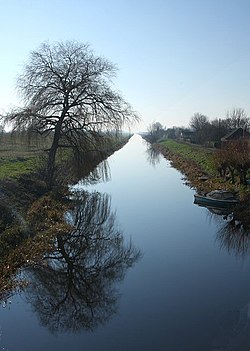Old Bedford River


The Old Bedford River is an artificial, partial diversion of the waters of the River Great Ouse in the Fens of Cambridgeshire and Norfolk. It is taken off the Great Ouse at Earith in Huntingdonshire, through which county it passes its first mile or so before entering Cambridgeshire. It then it runs in a straight line through Cambridgeshire and on through Norfolk to Denver, though in Norfolk it is labelled the River Delph, being there a diversion of that river.
The Old Bedford River was named after Francis Russell, 4th Earl of Bedford, who contracted with the local Commission of Sewers to drain the Great Level of the Fens beginning in 1630.
Origin
The idea of an artificial river running, as the Old Bedford River does, from Earith in Huntingdonshire to Denver in Norfolk was not a new idea; it had been proposed as early as 1604 by the engineer John Hunt.[1] The work on the Old Bedford River was financed by the Earl of Bedford and several other investors and was undertaken between 1630 and 1636, but the supervising engineer is not known.[2]
Artificial drainage of low-lying wetlands generally involves one or both of two different practices:
- excluding water flowing from high areas from entering the low-lying area, and
- pumping out water which does manage to get into the low-lying area.
The Old Bedford River was constructed on the first principle, as were most of the drainage works constructed in the seventeenth century in the English fens. Both the Old Bedford River and the New Bedford River (constructed 20 years later in 1650) were intended to reduce or eliminate flooding of the fens of the Great Level by carrying the bulk of the water from the Great Ouse from the uplands of Huntingdonshire to the sea in a straight channel, rather than allowing it to meander (and flood) the fens the Great Level.
Management
The flow in the Great Ouse is maintained for navigation, fisheries and aesthetic reasons but when there is excessive flow, the excess is diverted along the Bedford Rivers of which there are two, the Old and the New. Between them lies the Ouse Wash; an area in which excess fresh river water is stored until low tide permits its release or until flood levels elsewhere allow. The two rivers have raised banks so as to keep the flow within them but the outer bank in each case is higher so that when the flow becomes too great, the rivers fill the wash between them but not the farmland of the Middle and South Bedford Levels outside the banks.

To facilitate the drainage of the washland, there is a third, unembanked river between the two Bedford Rivers, alongside the Old Bedford River and known as the River Delph. It drains into the New Bedford River a mile or two south of Denver Sluice.
Names and development
The names of the three waterways are rather inconsistent. At Welches Dam (where the 1651 Forty Foot drain enters from the West) the Old Bedford River moves to the East and the Forty Foot actually enters the Counter Drain. It is the latter waterway which exits into the River Great Ouse just below Salters Lode. The actual Old Bedford River swaps identities in the Welches Dam area and becomes the River Delph. This dates back to when Forty Foot drain (also called Vermuyden's Drain) was cut.
The latter sometimes caused water to flow back up the Old Bedford river to Earith. To alleviate this a dam was built by Edmund Welche across the Old Bedford river just upstream of the junction of the two waterways. Unfortunately this caused the wash area between the Old and New Bedford rivers to flood so a new waterway was cut to link the stub of the Old Bedford River (from the point of the former dam) straight into the New Bedford River further upstream at Welmore Lake sluice.
This new waterway (which kinks to the right at Welches Dam before continuing parallel with the Old Bedford River) was named the River Delph and a flood bank was also built between it and the Old Bedford River to maintain the integrity of the Wash area [3]
See also
References
- ↑ Dugdale, William (1662). History of Imbancking.
- ↑ Knittl, Margaret Albright (2007). "The design for the initial drainage of the Great Level of the Fens: an historical whodunit in three parts". Agricultural History Review 55: 23–50.
- ↑ Blair, Andrew Hunter. Fenland Waterways. p. 38. ISBN 0-85288-759-0.